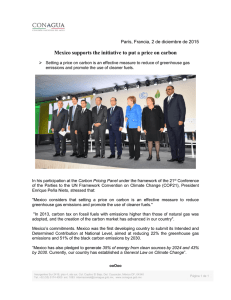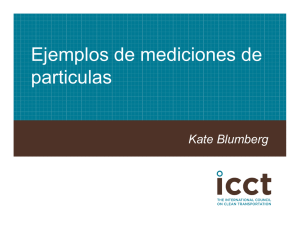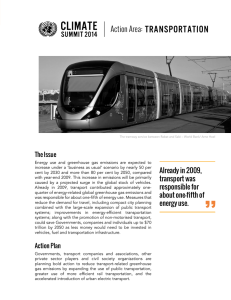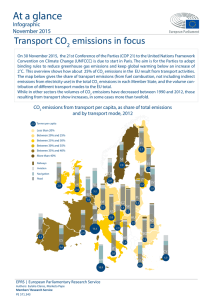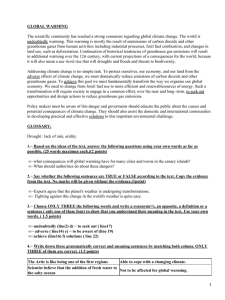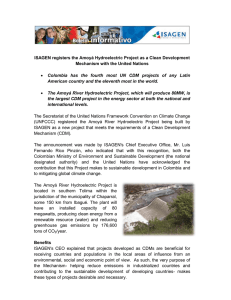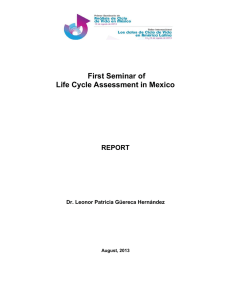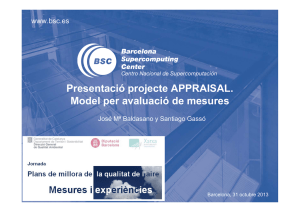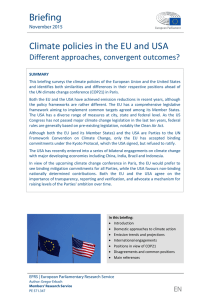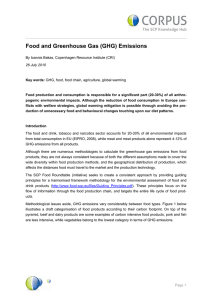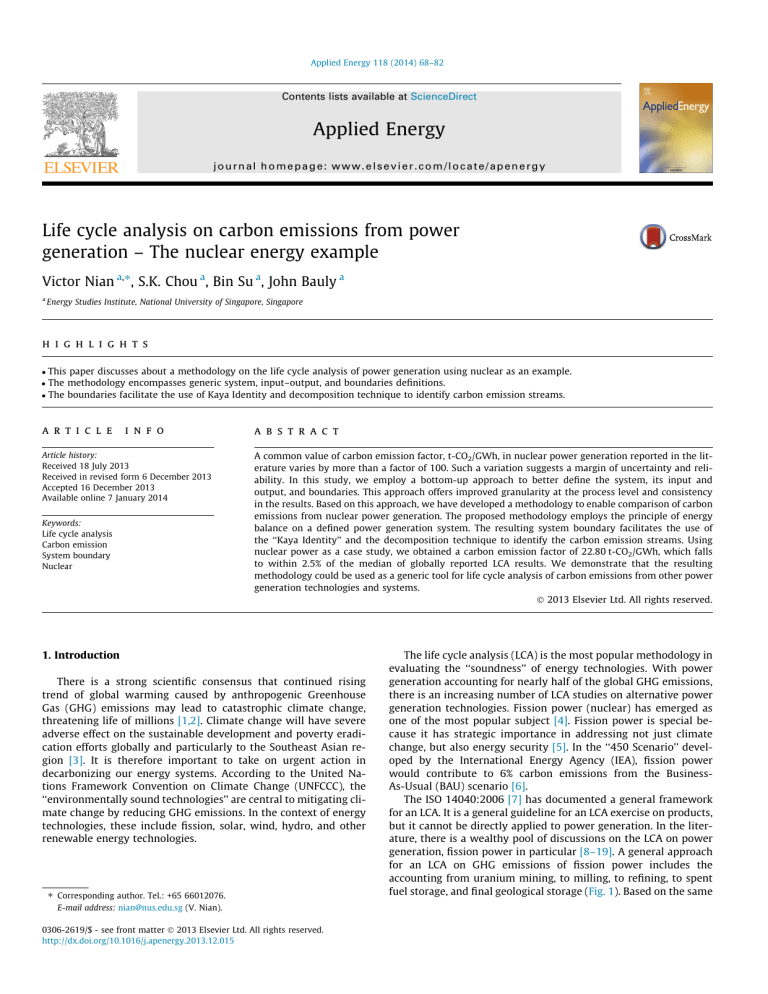
Applied Energy 118 (2014) 68–82 Contents lists available at ScienceDirect Applied Energy journal homepage: www.elsevier.com/locate/apenergy Life cycle analysis on carbon emissions from power generation – The nuclear energy example Victor Nian a,⇑, S.K. Chou a, Bin Su a, John Bauly a a Energy Studies Institute, National University of Singapore, Singapore h i g h l i g h t s This paper discusses about a methodology on the life cycle analysis of power generation using nuclear as an example. The methodology encompasses generic system, input–output, and boundaries definitions. The boundaries facilitate the use of Kaya Identity and decomposition technique to identify carbon emission streams. a r t i c l e i n f o Article history: Received 18 July 2013 Received in revised form 6 December 2013 Accepted 16 December 2013 Available online 7 January 2014 Keywords: Life cycle analysis Carbon emission System boundary Nuclear a b s t r a c t A common value of carbon emission factor, t-CO2/GWh, in nuclear power generation reported in the literature varies by more than a factor of 100. Such a variation suggests a margin of uncertainty and reliability. In this study, we employ a bottom-up approach to better define the system, its input and output, and boundaries. This approach offers improved granularity at the process level and consistency in the results. Based on this approach, we have developed a methodology to enable comparison of carbon emissions from nuclear power generation. The proposed methodology employs the principle of energy balance on a defined power generation system. The resulting system boundary facilitates the use of the ‘‘Kaya Identity’’ and the decomposition technique to identify the carbon emission streams. Using nuclear power as a case study, we obtained a carbon emission factor of 22.80 t-CO2/GWh, which falls to within 2.5% of the median of globally reported LCA results. We demonstrate that the resulting methodology could be used as a generic tool for life cycle analysis of carbon emissions from other power generation technologies and systems. Ó 2013 Elsevier Ltd. All rights reserved. 1. Introduction There is a strong scientific consensus that continued rising trend of global warming caused by anthropogenic Greenhouse Gas (GHG) emissions may lead to catastrophic climate change, threatening life of millions [1,2]. Climate change will have severe adverse effect on the sustainable development and poverty eradication efforts globally and particularly to the Southeast Asian region [3]. It is therefore important to take on urgent action in decarbonizing our energy systems. According to the United Nations Framework Convention on Climate Change (UNFCCC), the ‘‘environmentally sound technologies’’ are central to mitigating climate change by reducing GHG emissions. In the context of energy technologies, these include fission, solar, wind, hydro, and other renewable energy technologies. ⇑ Corresponding author. Tel.: +65 66012076. E-mail address: [email protected] (V. Nian). 0306-2619/$ - see front matter Ó 2013 Elsevier Ltd. All rights reserved. http://dx.doi.org/10.1016/j.apenergy.2013.12.015 The life cycle analysis (LCA) is the most popular methodology in evaluating the ‘‘soundness’’ of energy technologies. With power generation accounting for nearly half of the global GHG emissions, there is an increasing number of LCA studies on alternative power generation technologies. Fission power (nuclear) has emerged as one of the most popular subject [4]. Fission power is special because it has strategic importance in addressing not just climate change, but also energy security [5]. In the ‘‘450 Scenario’’ developed by the International Energy Agency (IEA), fission power would contribute to 6% carbon emissions from the BusinessAs-Usual (BAU) scenario [6]. The ISO 14040:2006 [7] has documented a general framework for an LCA. It is a general guideline for an LCA exercise on products, but it cannot be directly applied to power generation. In the literature, there is a wealthy pool of discussions on the LCA on power generation, fission power in particular [8–19]. A general approach for an LCA on GHG emissions of fission power includes the accounting from uranium mining, to milling, to refining, to spent fuel storage, and final geological storage (Fig. 1). Based on the same V. Nian et al. / Applied Energy 118 (2014) 68–82 69 Nomenclature Abbreviations BAU Business-As-Usual GDP Gross Domestic Product GHG Greenhouse Gas GWh Gigawatt hour IAEA International Atomic Energy Agency IEA International Energy Agency IPCC Intergovernmental Panel on Climate Change LCA Life Cycle Analysis LWR Light Water Reactor MACC Marginal Abatement Cost Curve MWD Megawatt Day PCA Process Chain Analysis SWU Separative Work Unit TWh Terawatt hour UNFCCC United Nations Framework Convention on Climate Change Symbols An the nth process of the ‘‘LCA Sub-system’’ on the ‘‘Energy Input’’ side an ‘‘product’’ of ‘‘Process’’ An Bn the nth process of the ‘‘LCA Sub-system’’ on the ‘‘NonEnergy Input’’ side bn ‘‘product’’ of ‘‘Process’’ Bn C carbon (GHG) emissions CExt extrinsic emission of ‘‘Process’’ input CInt intrinsic emission of ‘‘Process’’ input CFuel carbon emissions from the ‘‘Fuel’’ CLC life cycle carbon emissions from the ‘‘LCA Main System’’ Csys carbon emissions of a technological system CE carbon emissions due to ‘‘Energy Input’’ CE,n carbon emissions from ‘‘Process’’ (Pn) activities due to ‘‘Energy Input’’ CE-sub carbon emissions due to ‘‘Energy Input’’ at the immediate ‘‘Sub-system’’ Cf carbon emissions from fuel fabrication Cm carbon emissions from the mining CNE carbon emissions due to ‘‘Non-Energy Input’’ CNE,n carbon emissions from ‘‘Process’’ (Pn) activities due to ‘‘Non-Energy Input’’ CNE-sub carbon emissions due to ‘‘Non-Energy Input’’ at the immediate ‘‘Sub-system’’ Cp carbon emissions from power generation c carbon intensity or emission factor approach, several methodologies were developed specifically for fission power with corresponding life cycle GHG emission factors. However, the reported life cycle GHG emission factors varied by more than a factor 100 in the literature (Fig. 2). Therefore, it seems to suggest that the values and their associated methodologies may not all be reliable. In turn, these reliability issues may have severe consequences as many globally recognized studies are heavily relying on the LCA results from the literature. Pacala and Socolow [20] developed a methodology under which replacing conventional fossil fueled technologies with new and clean technologies could form wedges that would help stabilize the concentration of CO2 in the atmosphere. As mentioned earlier, the LCA results on power generation are relevant to the development the IEA’s 450 Scenario. In the discussion on future emission scenarios, the IPCC [21] employed ce,i ce,i cExt cint csys Ef Ef-in Ef-loss Ei,j,or k Ein Em-in Em-loss En Eloss Eout Ep-in e ei Fuel Memit Mf-res Mp-res MGHG Mres memit NEG NEin NEn NEi,j ne nei Pn Pe pn T e gsys s / or k carbon intensity of ‘‘Energy Input’’ carbon intensity of ‘‘Non-Energy Input’’ extrinsic emission factor of Process input intrinsic emission factor of Process input carbon emissions factor of a technological system the amount of energy or heat released from ‘‘Fuel’’ energy input to the fuel fabrication system energy loss of the fuel fabrication system ‘‘Energy Input’’ to each ‘‘Process’’ of the ‘‘LCA Main System’’ or ‘‘Sub-system’’ ‘‘Energy Input’’ to a system energy input to the mining system energy loss of the mining system ‘‘Energy Input’’ to support the ‘‘Process’’ activities energy loss of a system energy output from a system energy input to the power generation system energy intensity of product from a life cycle Process energy intensity of ‘‘product’’ pn by type the substance required to produce thermal energy mass of the emissions from a system mass of wastes (residues) from the fuel fabrication system wastes (residues) from the power generation system GHG emissions from power generation wastes (residues) produced from power generation emission factor of a system net energy gain ‘‘Non-Energy Input’’ (e.g. materials, facilities, etc.) to power generation ‘‘Non-Energy Input’’ to support the ‘‘Process’’ activities ‘‘Non-Energy Input’’ to each ‘‘Process’’ of the ‘‘LCA Main System’’ or ‘‘Sub-system’’ intensity of ‘‘Non-Energy Input’’ consumption of ‘‘product’’ in a ‘‘Process’’ intensity of ‘‘Non-Energy Input’’ required to ‘‘produce’’ pn by type the nth ‘‘Process’’ of the ‘‘LCA Main System’’ generating capacity of the plant product of the nth Process of the ‘‘LCA Main System’’ lifetime of the model plant (years) energy payback time (overall) system energy efficiency dimensionless energy payback time loading factor LCA results from the literature in benchmarking the emissions from alternative power generation technologies with key policy recommendations. These LCA results were also used by the consultants at Mckinsey for the development of a global Marginal Abatement Cost Curve (MACC) [22,23]. At the regional level, the ADB employed LCA results in the discussion about climate change in Southeast Asia [3]. At the country level, the U.S. Energy Information Administration employed LCA results for the agency’s Annual Energy Outlook series [24]. All of these authoritative findings will become unreliable with the use of unreliable LCA results. As such, it may lead to the wrong decision making, which could result in adverse effects in decarbonizing the energy systems. In brief, there are three problems with the LCA methodologies on power generation in the literature. First of all, there is a lack of standardized LCA methodology on power generation. As such, 70 V. Nian et al. / Applied Energy 118 (2014) 68–82 Fig. 1. General framework of an LCA on fission power generation. there is no common platform to benchmark the LCA results. Secondly, majority of the current methodologies are technology specific, which encumbers benchmarking among alternative power generation technologies. Lastly and most importantly, there is a lack of generic system representation on power generation technology. An LCA methodology on solar PV cannot be directly applied to fission power without significant adjustments. Furthermore, there is no methodology capable of benchmarking fission power with a complex power generation system, such as a hybrid diesel-backed solar PV system. The root cause to these problems lies with three ‘‘non-generic’’ definitions: (1) non-generic system definition, (2) non-generic input–output definition, and (3) non-generic system boundaries definitions. To systematically address the root cause, we propose a standardized methodology in this paper. In brief, the methodology is built upon the first principle and the decomposition technique. Key advantages of our methodology are: (1) the ability of evaluate and benchmark the life cycle carbon emission factors of alternative power generation systems, (2) balanced and unbiased energyemission analysis with accurate inclusion of emission streams, (3) evaluation of key indicators of an energy system, such as energy payback and (overall) system energy efficiency, and (4) the versatility of being applied to other aspects of an LCA, such as total waste generation and total natural resource consumption. This paper comprises of 6 sections. Section 1 is the introduction. In Section 2, we start with a literature survey using a scorecard method. In Section 3, we establish the proposed LCA methodology. In Section 4, we employ a reference light water reactor (LWR) plant as a numerical case study to validate the proposed methodology. In Section 5, we discuss about the benefits and limitations of the proposed methodology. In Section 6, we conclude the paper with recommendations for future work. 2. Literature review In the literature, there are broadly two approaches in conducing LCA exercises, the top down and the bottom up approaches. In the top down approach, the input–output (IO) method has emerged as Fig. 2. Life cycle emissions of fission power generation reported in the literature (logarithm plot). the most popular method. The IO method enables a standardized platform for scholars to evaluate energy systems in a multiregional setting [25,26], with the ability to estimate the feedback effects [27] among the different systems. It is a robust method in evaluating energy systems at the macroeconomic level. However, it is lacking in granularity at the engineering process level. The bottom up approach enables high granularity at this level. Although there is Process Chain Analysis (PCA) [15] in the bottom up approach, there is a lack of standardized methodology. As such, this paper focuses on the bottom up approach. There are four main criteria used in our literature review: LCA framework, LCA Scope, LCA System, and LCA Inventory Data. It is understood that these four criteria are important for an LCA to be accurate and objective. To enhance the granularity of our evaluation, each of the four main criteria was further divided into sub-criteria. Under the ‘‘LCA Framework’’, we examine whether the current LCA frameworks are generic enough to represent all power generation technologies; whether the methodology is capable of analyzing different aspects of the an LCA, such as GHG emissions, waste generation, system energy efficiency); and whether the LCA can accurately account for the emission streams. Under this criterion, there is a significantly lack of standardization among the published methodologies. Each published work represented a unique life cycle system even though they claimed to have been based on the same approach. There is lack of transparency in accounting for the emission streams, such as [10,19,28]. Under the ‘‘LCA Scope’’, we examine whether the current LCA methodologies degree of focus in conducting a cradle-to-grave analysis; whether the scopes can be systematically expanded to include more emission streams; and whether there is identifiable timeframe. Under this criterion, most of the published works seem to have diluted the scope for assessment with the most common dilution between the study on GHG emissions and waste stream generation, such as [10]. There is also ambiguity in the timeframe of assessment. Such ambiguity refers to the lack of distinction between the lifetime of a power plant and a complete uranium fuel cycle, such as [29,30]. Under the ‘‘LCA System’’, we examine whether the system and its input–output definitions are sufficiently generic to represent all possible power generation technologies; benchmark on the V. Nian et al. / Applied Energy 118 (2014) 68–82 granularity of the PCA used in the methodologies; critically examine the system boundaries defined in each methodology; and benchmark on the completeness of a cradle-to-grave life cycle definition. Under this criterion, there is a lack of a generic system and its associated input–output definitions, such as [12,13]; and there is little attention paid to the system boundaries, such as [9,11,15,31]. More critically, majority of the current methodologies are technology specific. An LCA for fission power cannot be directly apply to solar PV for benchmarking. As such, it is difficult to identify a common platform to benchmark the life cycle emission factors of alternative power generation technologies. Under the ‘‘LCA Inventory Data’’, we examine whether there are issues with the accessibility of the reference data; benchmark the granularity of the data used in the analysis; and examine whether the published methodology is based on the first principle. Under this criterion, there are issues with the accessibility of data, such as language barrier and proprietary restrictions. Many of the reference data are lacking in granularity, which greatly increase the difficulty in validation. In most instances, there is a lack of transparent analysis on fuel-to-fuel, and fuel-to-energy conversion but heavy reliance on secondary sources with only process or system emission factors, such as [14,32]. Pertaining to the system boundaries, Storm van Leeuwen [33] has clearly pointed out that ‘‘Many controversies with regard to fission power turn out to originate applying different system boundaries and time horizon: which processes and activities are included in the system and which are not. Often the system boundaries are not explicitly defined’’. Warner and Heath [30] developed a systematic view and harmonization of LCA on fission power generation. The objective of [30] was to determine the causes of variability in estimating the life cycle GHG emissions from fission power so as to reduce such variations. The harmonization has established consistent gross system boundaries and key values for system parameters. However, the transparency and granularity of the methodology can be further improved. More specifically, detailed analysis on why and how process inputs are included and/or excluded should be further discussed in the analysis. The root cause to these problems lies with the ‘‘Non-generic’’ definitions on the life cycle system, input–output, and system boundaries. To systematically address the root cause, the proposed methodology is built upon both quantitative and qualitative analysis. In defining the generic life cycle system, we follow closely the well-established PCA and Net-Energy Analysis. In addition, the quantifiable metrics for fuel-to-fuel and fuel-to-energy conversion from the first principle are added to the formulation. In defining the system boundaries, we employ the popular decomposition technique to reveal generic system boundaries. 3. The methodology 3.1. Defining a generic power generation system 71 Fig. 3. Generic definition of power generation system. Power generation typically produces more than one type of environmentally harmful byproducts such as emissions (airborne pollutants and GHGs) and wastes (Fig. 4). If it were coal, the combustion of ‘‘Fuel’’ would result in emissions, Memit (largely CO2 and airborne pollutants), and waste residues, Mres (e.g. coal ash). We could express the environmental emissions via Eq. (3) for system emission factor, memit. memit ¼ Memit =Eout ðt-Emission=GWhÞ ð3Þ In the case of solar PV or wind technology, Ein comes from the carrier excitation energy from photons (solar radiation) or the kinetic energy of moving air molecules. These processes do not involve the chemical conversion of ‘‘Fuel’’. As such, there is no release of airborne emissions (Memit = 0), or waste streams (Mres = 0) from the ‘‘Fuel’’. Thus, these technologies were classified as ‘‘clean’’ technologies. Applying Eq. (3) specifically for carbon (collectively representing all GHGs) emission factor: csys ¼ MGHG =Eout ðt-CO2 =GWhÞ ð4Þ To expand towards a life cycle system representation, we define two generic systems for Fuel Fabrication and Mining of Natural Resources respectively. To ensure consistency in the input–output definitions and system boundaries, we define these two systems in a similar approach. For Fuel Fabrication system, it comprises of energy input Ef-in, ‘‘Crude Energy’’ (in the form of natural resources, such as coal mines, uranium ore, or crude oil, ‘‘Fuel’’ output, energy losses in the fabrication process Ef-loss, carbon emissions Cf, and waste residues Mf-res. The Mining system can be defined in the same approach. For the power generation system, it comprises of energy input Ein from the conversion of Fuel, energy (electricity) output Eout, energy loss in the power generation process Ep-loss, carbon emissions Cp, and waste residues Mp-res (Fig. 5). In this case, the energy input, Ef-in and Em-in to the system refers to the energy input required to build, operate and maintain, and decommission the system with losses to the surroundings. Since We define a generic power generation system by extending the cyclic process representation [34] into a generic system representation. The generic power generation system receives energy input, Ein to produce useful energy output, Eout, and energy losses to the surroundings, Eloss, (Fig. 3). The energy input could come from the thermal energy produced in a furnace or fission reactor, kinetic energy from the flow of air or water molecules (wind or hydro), or carrier excitation energy from photon (solar radiation). Under this system boundary and input–output definitions, we could express the energy balance with Eq. (1), and the system energy efficiency with Eq. (2). Eout ¼ Ein Eloss ð1Þ gsys ¼ Eout =Ein ð2Þ Fig. 4. Generic power generation system with representations on environmental impact. 72 V. Nian et al. / Applied Energy 118 (2014) 68–82 Fig. 5. Power generation and upstream fuel fabrication. they are consistently defined, we merge the two systems into a broader fuel fabrication system definition (Fig. 6). In the power generation system, Ef (directly converted from ‘‘Fuel’’) appeared to be the energy input for producing electricity. Comparing with the energy input definition of the Fuel Fabrication systems, there is inconsistency in system and input–output definitions. Fig. 6 still assumes a simplified conversion process from Fuel to electricity. There is a lack of emission streams from other activities, such as construction, operation and maintenance, and decommissioning activities. In a classical mechanical engineering viewpoint, ‘‘Fuel’’ enters the furnace or fission reactor to produce thermal energy (heat) through chemical conversion or fission reaction; the thermal energy (heat) is then used to raise steam (in the case of Rankine Cycle) that drives a turbine generator to produce electricity (Eout); the input ‘‘Fuel’’ then converts into airborne emissions (including pollutants), Memit and/or waste streams Mres. Moving beyond the classical thermodynamic principles towards a unified generic life cycle system representation, we ‘‘internalize’’ the ‘‘Fuel’’ to energy conversion process. At the same time, we introduce a new energy input definition Ep-in to the power generation system (Fig. 7). It is defined as the energy required to build, operate and maintain, and decommission the power generation system. In Fig. 6, Ep-loss was the energy loss from the ‘‘Fuel’’ to electricity conversion process alone, but in Fig. 7, Ep-loss refers to the aggregated energy loss from the consumption of Ep-in and Ef at the system level. Since the power generation system has been defined consistently, we merge the two system into a unified life cycle system representation (Fig. 8). The internalization of ‘‘Crude Energy’’ to ‘‘Fuel’’ to Ef represents deterministic and finite internal energy generation. To complete the generic system representation, we add physical structures (e.g. blades of a turbine generator, reactor core for fission power, etc.) to the system representation in Fig. 8. We give these physical building blocks a generic input definition, ‘‘Non-Energy Input’’, denoted by NEin (Fig. 9). To simplify the representation of life cycle power generation process, we internalize the production of ‘‘Crude Energy’’ and ‘‘Fuel’’ to Ef conversion process. The final life cycle power generation system is schematized in Fig. 10. In the PCA approach, a life cycle system may comprise of n number of ‘‘Processes’’. Each ‘‘Process’’ comes from a standalone system, such as Fuel Fabrication system. Inputs to each ‘‘Process’’ are defined as generic ‘‘Energy Input’’ and ‘‘Non-Energy Input’’. Each ‘‘Process’’ produces a ‘‘product’’ to be used by the immediate next ‘‘Process’’ until the final ‘‘product’’ is produced. Based on such approach, Fig. 10 can be transformed into a generic multi-process, multi-input–output ‘‘LCA Main System’’ (Fig. 11). Using fission power as an example, ‘‘Energy Input’’ to the mining and milling ‘‘Process’’ could be electricity and/or heat (directly produced from coal, natural gas, or other primary energy sources); ‘‘Non-Energy Input’’ could be the mining facilities (made of concrete, steel, and other materials); ‘‘product’’ could be U3O8 for immediate next ‘‘Process’’ of conversion to UF6, and environmental emissions associated with ‘‘Energy Inputs’’ and ‘‘Fuels’’. Similarly, stages identified by different forms of uranium ‘‘products’’, from mining and milling, to conversion, enrichment, fuel fabrication, power generation, and spent-fuel disposal, are defined as ‘‘Processes’’ in the ‘‘LCA Main System’’, denoted as P1 to Pn (Fig. 11). The output from each process is defined collectively as ‘‘product’’ p1 to pn. The ‘‘Energy Input’’ and ‘‘Non-Energy Input’’ are collective representations, which could be disaggregated (e.g. into facility construction, operation and maintenance, and decommissioning) according to types and analytical objectives based on available data. Under such multi-process and multi-input–output system definitions, we re-write the energy balance equations relevant for subsequent analysis. First of all, the ‘‘Energy Input’’ to each ‘‘Process’’: Fig. 6. Schematic of a broader fuel fabrication system. V. Nian et al. / Applied Energy 118 (2014) 68–82 73 Fig. 7. New energy input definition for power generation system. Fig. 8. Formation of life cycle power generation system via system merging. Fig. 9. Complete life cycle power generation system input–output definition. Ein ¼ 1 X Ei ð5Þ i¼1 where Ei is the generic representation of each type of ‘‘Energy Input’’ to a ‘‘Process’’. In this equation, the variable ‘‘i’’ is an indicator that distinguishes the different types of activates/technologies of energy production. This equation also signifies that there can be a theoretically infinite number of activities consuming different types of ‘‘Energy Input’’ within a ‘‘Process’’. Second, the ‘‘Non-Energy Input’’ to each ‘‘Process’’: NEin ¼ 1 X NEi ð6Þ i¼1 Fig. 10. Generic life cycle power generation system. where NEi is the generic representation of each type of ‘‘Non-Energy Input’’ to a ‘‘Process’’. 74 V. Nian et al. / Applied Energy 118 (2014) 68–82 Fig. 11. Generic LCA Main System for power generation via PCA approach. Finally, the carbon emissions from each ‘‘Process’’: C¼ 1 1 X X ce;i Ei þ cne;i NEi þ C Fuel i¼1 ð7Þ i¼1 where C: carbon (GHG) emissions. c: carbon (emission) intensity of ‘‘Process’’ input. ce,i: carbon intensity of ‘‘Energy Input’’. ce,i: carbon intensity of ‘‘Non-Energy Input’’. CFuel: carbon emissions from the ‘‘Fuel’’. It is noteworthy that Eqs. (5)–(7) could also be further generalized to depict the total ‘‘Energy Input’’ and ‘‘Non-Energy Input’’ to the entire multi-process system, and the life cycle emissions from the system. In the subsequent representation, variable ‘‘n’’ is used to denote each ‘‘Process’’ of the system. Similar to the concept of variable ‘‘i’’, variable ‘‘n’’ is used as an indicator to distinguish the different ‘‘Processes’’ of an ‘‘LCA Main System’’. Thus, in the most generalizable representation, variable ‘‘n’’ also has a theoretical infinite upper limit. 3.2. Leveled system and system boundaries Relative to the definition of the ‘‘LCA Main System’’, we introduce ‘‘(LCA) Sub-system’’, and the ‘‘Leveled Sub-system’’ definitions in this section. These two definitions would introduce evolutionary progress in the understanding and application of system boundaries on power generation system. Without clearly and objectively applied boundaries, an LCA methodology could be biased to produce preferred or misinterpreted results; and decisions made from these results may lead to negative environmental impacts [35]. As such, the discussion on system boundaries forms an essential part of the proposed methodology. According to [36], there are four dimensions in defining the system boundaries for a physical product: (1) boundaries between the technological system and nature, (2) restrictions on the geographical area time horizon, (3) boundaries between the production of system goods, and production of capital goods, and (4) boundaries between the life cycle of the product studied and related life cycles of other products. The system boundaries arising from these four dimensions may apply well to a manufacturing product (such as car or mobile phone), but it requires adjustments and adaptations when applied to a power generation system. In this paper, we propose the following three dimensions in defining the system boundaries for power generation: (1) the boundaries between the technological system and its surroundings; (2) the boundaries between the ‘‘LCA Main System’’ and the ‘‘LCA Sub-systems’’; and (3) the regional boundaries for determining the geographical locations of each ‘‘Process’’ of the ‘‘LCA Main System’’, and the (cradle-to-grave) timeframe boundaries of the ‘‘LCA Main System’’. Compared with the four dimensions defined in [36], our proposed three dimensions corresponds to their 1st, 3rd and 4th, and 2nd dimensions respectively. The proposed 1st dimension, adapted from the cyclic process, states that for a multi-process technological system, ‘‘Energy Input’’ and ‘‘Non-Energy Input’’ were drawn from their surroundings to produce desired ‘‘product’’ (electricity in this case) at a given loss (e.g. waste heat) and GHG emissions rejected back into the surroundings. By applying the energy balance equations, one can compute the total energy consumed by the technological system and total energy loss to the surroundings. With the inclusion of internal energy generation, one can further compute some important indicators for a given energy system, such as the net energy gain (NEG) and system energy efficiency. The proposed 2nd dimension introduces the definition of the ‘‘LCA Sub-system’’. To each ‘‘Process’’ of the ‘‘LCA Main System’’, there are ‘‘Energy Input’’ and ‘‘Non-Energy Input’’. These inputs are produced by an ‘‘LCA Main System’’ of their own before they are available as ‘‘inputs’’. These input-producing systems, relative to the ‘‘LCA Main System’’ are defined as the ‘‘LCA Sub-systems’’. Between the ‘‘LCA Main System’’ and ‘‘LCA Sub-systems’’, there exist system boundaries. This dimension would serve as the fundamental basis for our subsequent discussions on the accurate tracking of emission streams. Following the same concept, the ‘‘Energy Input’’ and ‘‘Non-Energy Input’’ to the ‘‘LCA Sub-system’’ are produced by their respective ‘‘LCA Main System’’. The expansion of such a system structure leads to the establishment of a ‘‘Leveled System Structure’’ (Fig. 12). Under the ‘‘Leveled System Structure’’, each ‘‘LCA Sub-system’’ is defined as ‘‘Leveled Sub-system’’. For simplicity, we denote the ‘‘Energy Input’’ as ‘‘E’’, the ‘‘Non-Energy Input’’ as ‘‘NE’’, and each ‘‘LCA Sub-system’’ as ‘‘Sys’’. The dotted vertical lines represent the stepwise expansion to the nth level. The proposed 3rd dimension defines the geographical and timeframe boundaries. This dimension is somewhat flexible as it can be influenced by the agenda of an LCA. In general, there are two degrees of freedom in this structure, vertical and horizontal. The vertical expansion of system processes involves the expansion of geographical locations, and hence the regional boundaries of the ‘‘LCA Main System’’. The horizontal expansion across the leveled sub-systems involves the expansion of timeframe and also geographical boundaries. Vertically, there must be at least one ‘‘Process’’ (power generation) involved in the analysis. Horizontally, Level 0 refers to the timeframe of ‘‘LCA Main System’’; and Level n is the nth step expansion for tracing the emission streams for inputs. A complete vertical expansion is the true ‘‘cradle-to-grave’’ assessment of the ‘‘LCA Main System’’. A complete vertical and horizontal expansion traces back to the first unit of natural resources harvested for energy production since pre-industrialization for the ‘‘LCA Main System’’. 3.3. The energy-emission analysis Conventional LCA exercises account for the emission streams from both energy (‘‘Energy Input’’) and materials (‘‘Non-Energy Input’’). However, there is a lack of transparency and accuracy when including the emission streams from materials. The lack of transparency and accuracy can lead to unreliable results. To improve the transparency and accuracy in tracking the streams of emissions relevant to the ‘‘LCA Main System’’, we introduce the following equation: V. Nian et al. / Applied Energy 118 (2014) 68–82 75 Fig. 12. Expanded view of leveled system structure. C ¼ C Ext þ C Int ð8Þ where C: the emission due to Energy or Non-Energy Input. CExt: the extrinsic emission. CInt: the intrinsic emission. The intrinsic emission refers from the conversion of carbon contents of the ‘‘Input’’ when it is utilized by the ‘‘Process’’ of the ‘‘LCA Main System’’. The extrinsic emission refers to the emissions from the ‘‘LCA Sub-system’’ that makes the ‘‘Input’’ available to the ‘‘LCA Main System’’. The conversion of carbon contents of coal into CO2 during combustion produces intrinsic emission. The production of coal from its associated ‘‘LCA Sub-system’’ produces the extrinsic emission (Fig. 13). It is also interpreted as the ‘‘embodied’’ emission. In the ‘‘Leveled’’ system structure, there is a clearly defined system boundary between the ‘‘LCA Main System’’ and its ‘‘Leveled Sub-systems’’. In equivalence, the extrinsic emission is the same as the life cycle emission of the ‘‘Non-Energy Input’’. For a transparent and accurate LCA exercise, the inclusion of emission streams due to ‘‘Non-Energy Input’’ requires careful analysis. To quantify the discussions on the boundaries, we employ the decomposition technique to the Kaya Identity [21]: GDP Energy Emissions ¼ Population Population GDP Emission Energy ð9Þ To represent a generic life cycle system, we re-write the Kaya Identity into one that depicts ‘‘product’’ conversion at each process with its associated energy intensity and carbon intensity in a multi-process system. pn En Cn ¼ pn en cn pn1 pn En pn NEn Cn ¼ pn nen cn ¼ pn1 pn1 pn NEn C E;n ¼ pn1 C NE;n ð10Þ ð11Þ where CE,n: carbon emissions from ‘‘Process’’ (Pn) activities due to ‘‘Energy Input’’. CNE,n: carbon emissions from ‘‘Process’’ (Pn) activities due to ‘‘Non-Energy Input’’. Fig. 13. Tracking the sources of emissions (intrinsic vs. extrinsic). 76 V. Nian et al. / Applied Energy 118 (2014) 68–82 En: ‘‘Energy Input’’ to support the activities within ‘‘Process’’, Pn. NEn: ‘‘Non-Energy Input’’ to support the ‘‘Process’’ activities. pn1: ‘‘product’’ from upstream ‘‘Process’’, Pn. pn/pn1: conversion efficiency of ‘‘Process’’ Pn1 or productivity of pn1. En/pn: energy intensity of ‘‘product’’, pn. Cn/En: carbon intensity of ‘‘Energy Input’’. pn: ‘‘product’’ of ‘‘Process’’, Pn. en: energy intensity of ‘‘product’’, pn. nen: intensity of ‘‘Non-Energy Input’’ required to produce pn. cn: carbon intensity of ‘‘Energy Input’’ or ‘‘Non-Energy Input’’. In the case of a multi-process-input system, the total emissions due to ‘‘Energy Input’’ and ‘‘Non-Energy Input’’ are given respectively as follows after applying Eq. (8): CE ¼ " # 1 1 1 X X X C E;n ¼ pn ðei ðcExt;i þ cInt;i ÞÞ n¼1 C NE ¼ n¼1 " # 1 1 1 X X X C NE;n ¼ pn ðnei ðcExt;i þ cInt;i ÞÞ n¼1 ð12Þ i¼1 n¼1 ð13Þ i¼1 The life cycle emission of the ‘‘LCA Main System’’ (CLC) is the aggregate of ‘‘Process’’ emissions due to ‘‘Energy Input’’ (CE), ‘‘NonEnergy Input’’ (CNE), and ‘‘Fuel’’ (CFuel). C LC ¼ C E þ C NE þ C Fuel ð14Þ Following the same procedure as the life cycle emission derivation, the total ‘‘Energy Input’’ (Esys) and ‘‘Non-Energy Input’’ (NEsys) are as follows: Esys ¼ 1 X n¼1 NEsys ¼ 1 X n¼1 1 X pn ei ! i¼1 pn 1 X nei ð15Þ ! ð16Þ i¼1 where ei: energy intensity of ‘‘product’’ pn by type. nei: intensity of ‘‘Non-Energy Input’’ required to ‘‘produce’’ pn by type. Quantifying the definition of extrinsic emission, we could obtain the following equation: C Ext ¼ C E-sub þ C NE-sub ð17Þ where CE-sub: carbon emissions due to ‘‘Energy Input’’ at the immediate ‘‘LCA Sub-system’’. CNE-sub: carbon emissions due to ‘‘Non-Energy Input’’ at the immediate ‘‘LCA Sub-system’’. For transparent and accurate evaluation of the total ‘‘Energy Input’’, ‘‘Non-Energy Input’’, and carbon emissions, the leveled sub-system structure should be expanded on both sides of the ‘‘LCA Main System’’ in a balanced manner. Each crossing of the leveled system boundary involves the decomposition of CInt and CExt. The accounting of CExt involves the decomposition into CE-sub and CNE-sub. Conceptual diagrams depicting the procedures of such an exercise are represented by Fig. 14 on the ‘‘Energy Input’’ side and Fig. 15 on the ‘‘Non-Energy Input’’ side up to Level 2 expansion. Based on the decomposition exercise reported in [37], we could obtain the following life cycle emission equations (under the assumption that ‘‘Non-Energy Input’’ does not convert nor decompose into GHG emissions) at Level 0 (CLC,0) and Level 1 (CLC,1): C LC;0 ¼ " 1 X n¼1 pn # 1 X ðei cInt;i Þ þC Fuel i¼1 ð18Þ " #! 0 X 113 1 1 X an ðej cInt;j Þ 7 6 B B CC 1 6 1 B 7 X X B n¼1 CC j¼1 6 C7 B þcInt;i C C LC;1 ¼ 6pn C7 Bei B B C 6 C B E i @ AA7 n¼1 4 i¼1 @ 5 2 0 0 " #!113 0 X 1 1 X a e ðc Þ 7 6 B n j Int;j CC B 1 6 1 B 7 X X CC B n¼1 j¼1 6 C7 B C B þ p ne 6 n C7 þC Fuel B i B C 7 6 B NEi AC @ n¼1 4 i¼1 @ A5 2 ð19Þ The procedures for analysis at all other levels are similar, and therefore not explained in this paper. Essentially, there are five important observations: (1) the intrinsic emissions of ‘‘Energy Input’’ (to the ‘‘LCA Main System’’) have been inherited since the beginning of the decomposition exercise; (2) at each crossing of the system boundary, extrinsic emissions is decomposed into CE-sub and CNE-sub; (3) cutting off at any level, intrinsic emissions are retained and extrinsic emissions are eliminated; (4) the summation of CE-sub and CNE-sub in Eq. (17) of a given ‘‘Energy Input’’ or ‘‘Non-Energy Input’’ to the nth level is effectively the life cycle emission of this ‘‘Input’’ produced at Level n + 1 (n P 0); and (5) the life cycle emission calculation appears to be only relevant to the intrinsic emissions of leveled ‘‘Energy Inputs’’ and ‘‘Non-Energy Input’’. Under the assumption of ‘‘0’’ intrinsic emission from the ‘‘Non-Energy Input’’, only intrinsic emissions of ‘‘Energy Inputs’’ are relevant to the life cycle mission equations. We believe that Observations (3), (4), and (5) are the root cause of the unreliability in the current LCA methodologies on power generation. The inaccurate inclusion of emissions streams from ‘‘Non-Energy Input’’ and/or insufficient granularity on emission streams accounting for ‘‘Energy Input’’ could be causing the huge variations among the LCA results on fission power. With our proposed methodology, the streamlined procedures for conducting life cycle emission analysis minimize the problem of under- or overaccounting of emission sources. 4. Case study – a reference LWR plant for Singapore To test the assumptions and validate the methodology, we employ a reference LWR plant in this case study. Besides emission calculation, we also include a brief calculation on the net energy gain and system energy efficiency. The reference plant is assumed to operate under the conditions specified in Table 1. With these conditions, the plant yields 368 TWh (1.3 EJ) of electric energy (Eout) over its lifetime. Based on a typical uranium burn-up value of about 45,000 MWD/t-U, we could obtain the uranium requirement for each ‘‘Process’’ of the fission power generation system based on uranium fuel cycle calculation in [37]. The uranium ‘‘product’’ requirement for each ‘‘Process’’ is summarized in Fig. 16. The primary data for our case study are sourced from [37] given its high data quality and granularity. The study conducted in [37] was in reference to a model Japanese LWR plant. Both Singapore and Japan share similar national circumstances, such as economic development, technological advancement, and land constraint. Since Singapore does not have a fission power plant, data provided in [37] serves as a good reference. Depending on the choice of enrichment method (gaseous diffusion and centrifuge) and locations, we construct a reference global uranium supply chain (Fig. 17). Based on such uranium supply chain and our primary data source, we obtain the life cycle emissions due to both ‘‘Energy Input’’ and ‘‘Non-Energy Input’’ values by Scenario (Table 2) and the average values by ‘‘Process’’ (Table 3). V. Nian et al. / Applied Energy 118 (2014) 68–82 Fig. 14. Diagram for decomposing at Level 2 on the ‘‘Energy Input’’ side. Fig. 15. Diagram for decomposing at Level 2 on the ‘‘Non-Energy Input’’ side. 77 78 V. Nian et al. / Applied Energy 118 (2014) 68–82 Table 1 Operating conditions of the reference LWR plant. Parameters Values Installed capacity Loading factor Average thermal efficiency Lifetime 1000 MW 70% 33% 60 Years These inputs are related to all the identifiable activities of a given ‘‘Process’’, including facility construction, operation and maintenance, decommissioning, and uranium ‘‘product’’ transportation from one location to another. The median value of the life cycle emission factors identified for this paper is found to be about 22.25 t-CO2/GWh. Our case study result (25.03 t-CO2/GWh) deviates from the median value by about 12.5% (Fig. 18). To better understand the impact of the embodied emissions of ‘‘Non-Energy Input’’, we applied the system boundary definitions at Level 0, which exclude the emission streams from ‘‘Non-Energy Input’’. Under our boundary definitions, our case study result becomes 22.80 t-CO2/GWh (Table 2, Column 2). At the value of 22.80 t-CO2/GWh, the error margin reduced from 12.5% to less than 2.5% (Fig. 19). For better illustration, the average life cycle emission factors were summarized in Table 4. In absolute terms, the ‘‘Non-Energy Input’’ contributes to less than 9% of the total emission factor. The difference before and after the exclusion of ‘‘Non-Energy Input’’ emissions is trivial given that an emission factor of 25.03 t-CO2/GWh is considered very small for a power generation technology. However, it is arguable whether the more than fourfold difference in error margin from the median value is acceptable. Therefore, it seems to suggest if the inclusion of emissions due to ‘‘Non-Energy Input’’ requires further analysis on the data source. More importantly, it requires more detailed analysis at ‘‘Sub-system’’ level for each ‘‘Non-Energy Input’’. Fig. 16. Uranium fuel cycle calculation results. Fig. 17. Global uranium supply chain adapted for Singapore’s reference LWR plant. V. Nian et al. / Applied Energy 118 (2014) 68–82 79 Table 2 Case study results for the reference LWR plant in Singapore. ‘‘Energy Input’’ t-CO2/GWh (%) ‘‘Non-Energy Input’’ t-CO2/GWh (%) Total t-CO2/GWh (%) Scenario 1 31.11 (94.06%) 1.96 (5.94%) 33.07 (100%) Scenario 2 18.61 (89.03%) 2.32 (10.97%) 20.93 (100%) Scenario 3 18.68 (88.60%) 2.4 (11.40%) 21.08 (100%) Average 22.80 (91.12%) 2.23 (8.88%) 25.03 (100%) Table 3 Average results by ‘‘Process’’ for the reference LWR plant in Singapore (unit: t-CO2/ GWh). Process ‘‘Energy Input’’ ‘‘Non-Energy Input’’ Total Mining and milling Conversion Enrichment Re-conversion Power Generation SF interim storage SF disposal 1.12 0.28 4.98 0.76 15.13 0.09 0.43 0.33 0.05 0.32 0.02 1.31 0.07 0.12 1.45 0.34 5.30 0.78 16.44 0.17 0.55 Total 22.80 2.23 25.03 Fig. 18. Benchmarking case study results. 5. Discussions There are multiple benefits with the developed methodology. First of all, the generic definitions on system and its associated input–output and boundaries enable the representation beyond electricity generation systems. In this sense, the system definition is capable of representing complex energy technology systems including future unknown energy systems (a system drawing from an unknown energy source). The ‘‘Leveled Sub-system’’ concept allows for balanced expansion for complete and accurate accounting of all emission streams across timeframe and geographical regions. Fig. 19. Benchmarking case study results with exclusion of ‘‘Non-Energy Input’’ emissions. The multiple dimensions governing the system boundary definitions guarantee a transparent and unbiased analysis and benchmarking. Fourth, this methodology could be transformed into a life cycle cost analysis (LCCA) by associating each input with a price (cost). Finally, this methodology also allows for the assessment of other impacts brought about by the given life cycle of the system, such as total natural resource consumptions, and total production of radioactive substance (in the case of fission energy). These can be systematically computed and assessed based on itemized ‘‘Non-Energy Input’’ to each ‘‘Process’’. The drawback of our methodology is data intensive, which is common among all PCA driven methodologies. As our methodology is primarily driven by high quality data, insufficient data granularity would very likely result in over- or under-counting in the assessment of energy-emission indicators. It is therefore imperative for life cycle analysts to pay special attention and effort in harvesting transparent and meaningful data for assessments. To overcome the issues with data granularity, it requires the government to institute feasible policy from the top down to ensure transparency and high quality reporting of process energy consumptions by the respective industries. At the same time, it requires the electricity producers and technological system suppliers to actively respond in reporting from the bottom up. We recognize the difficulty and sensitivity of disclosing such data, but we believe that collective reporting and publishing of meaningfully normalized values could large mitigate the sensitivity issues. We would also like to highlight another point about our methodology. Following a balanced systematic LCA on power generation, the inclusion of emissions streams due to the use of ‘‘Non-Energy Input’’ requires the inclusion of extrinsic emissions at the ‘‘LCA Sub-system’’ level on the ‘‘Energy Input’’ side. In this case, it could lead to a continuous inclusion of emission from ‘‘Non-Energy Input’’, resulting in a potentially infinite expansion of the LCA effort until it reaches the very first unit of natural resources mined at preindustrialization. It is a laborious and resource consuming procedure. Therefore for an LCA focusing on the ‘‘LCA Main System’’, it is necessary for the analyst to identify suitable cut-off point by exercising boundary definitions. 80 V. Nian et al. / Applied Energy 118 (2014) 68–82 Table 4 Error analysis of life cycle emission calculation case studies. Method Emission factor (t-CO2/GWh) Median value (t-CO2/GWh) Error margin (%) Life cycle emission analysis Exclusion of embodied emissions of ‘‘Non-Energy Input’’ 25.03 22.80 22.25 12.48 2.47 6. Concluding remarks In this paper, we have developed a generic methodology capable of standardizing all LCA methodologies in the literature for power generation. Built upon the principle of energy balance, the concept of ‘‘Kaya Identity’’, and the decomposition technique, we have clarified the issues with the system boundaries and quantitatively resolved controversies on the inclusion/exclusion of emission sources. With the establishment of the ‘‘Leveled Sub-system’’ concept, the methodology could lead to an accurate accounting on the streams of carbon emissions. As validation, a comprehensive numerical case study was conducted on a reference LWR plant. Depending on the choice of uranium enrichment methods, the life cycle carbon emission factors of fission power range from 21.08 to 33.07 (25.03 in average) t-CO2/ GWh. With the carbon emission streams from ‘‘Non-Energy Input’’ excluded, the carbon emission factor reduced to about 18.68– 31.11 (22.80 in average) t-CO2/GWh. On average, the deviation from the median reduced from 12.5% to less than 2.5%. On absolute terms, the ‘‘Non-Energy Input’’ related carbon emissions contributed to less than 9% of life cycle emission factor. On the account that the life cycle emission factor is already very small, 9% contribution is trivial, especially when considering the long operating life of the LWR plant. Therefore, it is justifiable for the exclusion of ‘‘Non-Energy Input’’ related carbon emissions for fission power generation technologies to reduce the data intensity of an LCA exercise. Lastly, the proposed methodology can be considered as possible improvements to the existing computerized LCA tools, such as GaBi and SimaPro. The proposed methodology can also be computerized as a standalone tool for LCA on energy systems. We recommend that the computerization of the proposed methodology as future development work. Appendix A See Table A1. References [1] IPCC. Climate change 2007: impacts, adaptation and vulnerability: contribution of working group II to the fourth assessment report of the intergovernmental panel on climate change. Cambridge, UK; New York: Intergovernmental Panel on Climate Change; 2007. [2] IPCC. Climate change 2007: the physical science basis: contribution of working group I to the fourth assessment report of the intergovernmental panel on climate change. Cambridge; New York: Intergovernmental Panel on Climate Change; 2007. [3] ADB. The economics of climate change in Southeast Asia: a regional review. Mandaluyong City, Metro Manila, Philippines: Asian Development Bank; 2009. [4] van de Vate JF. Comparison of energy sources in terms of their full energy chain emission factors of greenhouse gases. Energy Policy 1997;25:1–6. [5] Nian V, D’Souza NS. Will Fukushima impede the nuclear renaissance? In: Yan J, editor. International conference of applied energy. Suzhou, China: Elsevier; 2012. p. 355–64. [6] IEA. Energy technology perspectives 2008 – scenarios and strategies to 2050. Paris: International Energy Agency (IEA); 2008. [7] ISO. Environmental management – life cycle assessment, principles and framework. International Standard Organization; 2006. p. 28. [8] Hondo H. Evaluation of nuclear power generation technologies based on life cycle emissions. Central Research Institute of Electric Power Industry; 2001. [9] Hondo H. Life cycle GHG emission analysis of power generation systems: Japanese case. Energy 2005;30:2042–56. Table A1 Summary of LCA results reported in the literature. Published works Life cycle emission factors (t-CO2/GWh) Published works life cycle emission factors (t-CO2/GWh) Barnaby and Kemp [38] British Energy [40,41] Delucchi [43] Dones et al. [45,46] Dones et al. [16] Dones et al. [49] Ethan et al. [30] Echávarri [32] Fleming [52] Fritsche [54] Fritsche and Lim [17] Fthenakis and Alsema [56] Fthenakis and Kim [58] Gagnon et al. [60] Heede [62] Hondo [8] Hondo [9] IAEA [65] IEA [66] IEA [67] IPCC [69] ISA [70] Koch [72] Kivisto [74] Krewitt et al. [76] Kulcinski [78] Lenzen [15] 84–122 5.05 26 7.6–14.3 9–80 5–12 12 2.6–5.5 88–134 34 64 20–40 16–55 15 2.5–5.7 23.6–28.7 24 10 30–60 2.8–26 45 10–130 2–59 17–59 19.7 15 10–130 Meier [31] 17 Mortimer [39] Proops et al. [42] Rashad and Hammad [44] Ruether et al. [47] Science Concepts [48] Sovacool [11] Spadaro et al. [50] Storm van Leeuwen and Smith [51] Storm van Leeuwen [53] Storm van Leeuwen and Smith [12] Sustainable Development Commission [55] Tahara et al. [57] Taylor [59] Tokimatsu et al. [61] Tokimatsu et al. [18] Uchiyama [63] Utgikar and Thiesen [64] van de Vate [4] van de Vate [14] Weisser [68] White [28] White and Kulcinski [71] World Energy Council [73] World Nuclear Association [75] World Nuclear Association [77] Median Max Min Magnitude of variation 47–54 2.83 26.4 3 30 66 2.5–5.7 84–122 92–141 112.47–165.72 2–20 1.8 19.7 20.9 10–200 10.5–47 2–59 9 8.9 2.8–24 34.1–37.7 15 3–40 15–30 6–26 22.25 200 1.8 111 V. Nian et al. / Applied Energy 118 (2014) 68–82 [10] Hondo H, Uchiyama Y, Morizumi Y. Evaluation of power generation technologies based on life cycle CO2 emissions. Central Research Institute of Electric Power Industry; 2000. p. 105. [11] Sovacool BK. Valuing the greenhouse gas emissions from nuclear power: a critical survey. Energy Policy 2008;36:2950–63. [12] Storm van Leeuwen JW, Smith PB. Nuclear power – the energy balance. Chaam, The Netherlands: Ceedata Consultancy; 2007. [13] Storm van Leeuwen JW, Smith PB. Nuclear power – the energy balance. Chaam, The Netherlands: Ceedata Consultancy; 2008. p. 331. [14] van de Vate JF. Full-energy-chain greenhouse-gas emissions: a comparison between nuclear power, hydropower, solar power, and wind power. Int J Risk Assess Manage 2002:3. [15] Lenzen M. Life cycle energy and greenhouse gas emissions of nuclear energy: a review. Energ Convers Manage 2008;49:2178–99. [16] Dones R, Zhou X, Tian C. Life Cycle Assessment (LCA) of Chinese energy chains for Shandong electricity scenarios. Int J Global Energy Issues 2004;22:25. [17] Fritsche UR, Lim S-S. Comparison of greenhouse-gas emissions and abatement cost of nuclear and alternative energy options from a life-cycle perspective. Darmstadt, Germany: Öko-Institut – Institute for Applied Ecology; 2006. p. 11. [18] Tokimatsu K, Kosugi T, Asami T, Williams E, Kaya Y. Evaluation of lifecycle CO2 emissions from the Japanese electric power sector in the 21st century under various nuclear scenarios. Energy Policy 2006;34:833–52. [19] Hondo H, Uchiyama Y, Morizumi Y. Evaluation of power generation technologies based on life cycle CO2 emissions – re-estimation using the latest data and effects of the difference of conditions. Central Research Institute of Electric Power Industry; 2000. p. 105. [20] Pacala S, Socolow R. Stabilization wedges: solving the climate problem for the next 50 years with current technologies. Science 2004;305:968–72. [21] IPCC. IPCC special report emission scenarios. In: Nakicenovic N, Swart R, editors. Summary for policy makers: intergovernmental panel on climate change; 2000. [22] Mckinsey. A cost curve for greenhouse gas reduction. In: Enkvist P-A, Naucler T, Rosander J, editors. The Mckinsey quarterly. Stockholm, Sweden: Mckinsey & Company; 2007. [23] Mckinsey. Impact of the financial crisis on carbon economics: version 2.1 of the global greenhouse gas abatement cost curve. In: Enkvist P-A, Dinkel J, Lin C, editors. The Mckinsey quarterly. Stockholm, Sweden: Mckinsey & Company; 2010. [24] U.S.EIA. Annual energy outlook 2012 with projection to 2035. USA: U.S. Energy Information Administration; 2012. [25] Su B, Ang BW. Input–output analysis of CO2 emissions embodied in trade: competitive versus non-competitive imports. Energy Policy 2013;56:83–7. [26] Su B, Ang BW, Low M. Input–output analysis of CO2 emissions embodied in trade and the driving forces: processing and normal exports. Ecol Econ 2013;88:119–25. [27] Su B, Ang BW. Multi-region input–output analysis of CO2 emissions embodied in trade: the feedback effects. Ecol Econ 2011;71:42–53. [28] White SW. Energy balance and lifetime emissions from fusion, fission, and coal generated electricity [Master of Science]. Madison: University of Wisconsin; 1995. [29] Dones R, Heck T, Emmenegger MF, Jungbluth N. Life cycle inventories for the nuclear and natural gas energy systems, and examples of uncertainty analysis. Int J Life Cycle Assess 2005;10:10–23. [30] Warner ES, Heath GA. Life cycle greenhouse gas emissions of nuclear electricity generation. J Ind Ecol 2012;16:S73–92. [31] Meier PJ. Life-cycle assessment of electricity generation systems and applications for climate change policy analysis [3060403]. United States, Wisconsin: The University of Wisconsin – Madison; 2002. [32] Echávarri LE. Is nuclear energy at a turning point? Electr J 2007;20:89–97. [33] Storm van Leeuwen JW. Nuclear power, energy security and CO2 emissions. Brussels: Ceedata Consultancy; 2012. [34] Çengel YA, Boles MA. Thermodynamics: an engineering approach. 5th ed. Boston: McGraw-Hill Higher Education; 2006. [35] Lee JJ, O’Callaghan P, Allen D. Critical review of life cycle analysis and assessment techniques and their application to commercial activities. Resour Conserv Recycl 1995;13:37–56. [36] Tillman A-M, Ekvall T, Baumann H, Rydberg T. Choice of system boundaries in life cycle assessment. J Clean Prod 1994;2:21–9. [37] Nian V, Chou SK, Bauly JA, Su B. Life cycle energy-emission analysis on power generation systems – the nuclear example. ESI working paper. Singapore: Energy Studies Institute, National University of Singapore; 2013. [38] Barnaby F, Kemp J. Secure energy? Civil nuclear power, security and global warming. London, UK: Oxford Research Group; 2007. [39] Mortimer N. Nuclear power and global warming. Energy Policy 1991;19:76–8. [40] British Energy. Environmental product declaration of electricity from Torness Nuclear Power Station. London, UK: British Energy Group Inc.; 2005. p. 49. [41] British Energy. Carbon footprint of the nuclear fuel cycle. London, UK: British Energy Group Inc.; 2006. p. 24. [42] Proops JLR, Gay PW, Speck S, SchrÖder T. The lifetime pollution implications of various types of electricity generation. An input–output analysis. Energy Policy 1996;24:229–37. [43] Delucchi MA. A Lifecycle Emissions Model (LEM): lifecycle emissions from transportation fuels, motor vehicles, transportation modes, electricity use, heating and cooking fuels, and materials; main report. Research report; 2003. 81 [44] Rashad SM, Hammad FH. Nuclear power and the environment: comparative assessment of environmental and health impacts of electricity-generating systems. Appl Energy 2000;65:211–29. [45] Dones R, Bauer C, Heck T. LCA of current coal, gas, and nuclear electricity systems and electricity mix in the USA. Switzerland: Paul Scherrer Institute; 2003. [46] Dones R, Heck T, Hirschberg S. Greenhouse gas emissions from energy systems: comparison and overview. Encycl Energy 2003;3:18. [47] Ruether JA, Ramezan M, Balash PC. Greenhouse gas emissions from coal gasification power generation systems. J Infrastruct Syst 2004;10:111–9. [48] Science Concepts. Reducing airborne emissions with nuclear electricity. Study for the US Council for Energy Awareness: Science Concepts; 1990. [49] Dones R, Heck T, Faist Emmenegger M, Jungbluth N. Life cycle inventories for the nuclear and natural gas energy systems, and examples of uncertainty analysis (14 pp). Int J Life Cycle Assess 2005;10:10–23. [50] Spadaro JV, Langlois L, Hamilton B. Greenhouse gas emissions of electricity generation chains: assessing the difference. IAEA Bulletin : International Atomic Energy Agency; 2000. p. 19–28. [51] Storm van Leeuwen JW, Smith PB. Nuclear power – the energy balance. Chaam, The Netherlands: Ceedata Consultancy; 2005. [52] Fleming D. The lean guide to nuclear energy: a life-cycle in trouble. November 2007 ed. The Lean Economy Connection; 2007. [53] Storm van Leeuwen JW. Nuclear power and global warming. Brussels: Ceedata Consultancy; 2006. [54] Fritsche UR. Comparing greenhouse gas emissions and abatement costs of nuclear and alternative energy options from a lifecycle perspective. In: CNIC conference on nuclear energy and greenhouse gas emissions. Tokyo, Japan; 1997. [55] Sustainable Development Commission. Reducing CO2 emissions – nuclear and the alternatives. The role of nuclear power in a low carbon economy: sustainable development commission; 2006. p. 41. [56] Fthenakis V, Alsema E. Photovoltaics energy payback times, greenhouse gas emissions and external costs: 2004–early 2005 status. Prog Photovoltaics Res Appl 2006;14:275–80. [57] Tahara K, Kojima T, Inaba A. Evaluation of CO2 payback time of power plants by LCA. Energ Convers Manage 1997;38(Suppl.):S615–20. [58] Fthenakis VM, Kim HC. Greenhouse-gas emissions from solar electric- and nuclear power: a life-cycle study. Energy Policy 2007;35:2549–57. [59] Taylor M. Greenhouse gases and the nuclear fuel cycle: what emissions? IAEA Bulletin: Uranium Institute; 1996. [60] Gagnon L, Bèlanger C, Uchiyama Y. Life-cycle assessment of electricity generation options: the status of research in year 2001. Energy Policy 2002;30:1267–78. [61] Tokimatsu K, Hondo H, Ogawa Y, Okano K, Yamaji K, Katsurai M. Energy analysis and carbon dioxide emission of Tokamak fusion power reactors. Fusion Eng Des 2000;48:483–98. [62] Heede R. Aspen greenhouse gas emission inventory, 2007 – an update to the 2004 baseline. Aspen, USA: Climate Mitigation Services; 2009. [63] Uchiyama Y. Validity of FENCH-GHG study, methodologies and databases. Comparison of energy sources in terms of their full-energy-chain emission factors of greenhouse gases. In: Proceedings of an IAEA advisory group meeting/workshop. Beijing, China: International Atomic Energy Agency (IAEA); 1994. [64] Utgikar V, Thiesen T. Life cycle assessment of high temperature electrolysis for hydrogen production via nuclear energy. Int J Hydrogen Energy 2006;31:939–44. [65] IAEA. The annual report for 1996 – comparative assessment of nuclear power and other energy sources. Vienna, Austria: International Atomic Energy Agency; 1997. [66] IEA. Energy and the environment, transport systems responses in the OECD – greenhouse gas emissions and road transport technology. Paris, France: International Energy Agency; 1994. [67] IEA. Environmental and health impacts of electricity generation: a comparison of the environmental impacts of hydropower with those of other generation technologies. IEA implementing agreement for hydropower technologies and programs. Ontario, Canada: International Energy Agency; 2002. [68] Weisser D. A guide to life-cycle greenhouse gas (GHG) emissions from electric supply technologies. Energy 2007;32:1543–59. [69] IPCC. Special report on renewable energy sources and climate change mitigation. United Kingdom and New York, NY, USA: Cambridge University Press; 2011. [70] ISA. Life-cycle energy balance and greenhouse gas emissions of nuclear energy in Australia. Sydney, Australia: Integrated Sustainability Analysis; University of Sydney, Australia; 2006. [71] White SW, Kulcinski GL. Birth to death analysis of the energy payback ratio and CO2 gas emission rates from coal, fission, wind, and DT-fusion electrical power plants. Fusion Eng Des 2000;48:473–81. [72] Koch FH. Hydropower-internalized costs and externalized benefits. IEA implementing agreement for hydropower technologies and programs. Ottawa, Canada: International Energy Agency; 2000. [73] World Energy Council. Comparison of energy systems using life cycle assessment. London, UK: World Energy Council; 2004. [74] Kivisto A. Energy payback period and carbon dioxide emissions in different power generation methods in Finland. In: Into the twenty-first century: harmonizing energy policy, environment, and sustainable economic growth, conference proceedings; 1995. p. 191–8. 82 V. Nian et al. / Applied Energy 118 (2014) 68–82 [75] WNA. Comparison of lifecycle greenhouse gas emissions of various electricity generation sources. WNA report. London, UK: World Nuclear Association; 2011. p. 10. [76] Krewitt W, Mayerhofer P, Friedrich R, Trukenmuller A, Heck T, Greßmann A. ExternE – externalities of energy. Directorate-General. Stuttgart, Germany: European Commission; 1998. [77] WNA. Energy analysis of power systems. 2012 Update of 2006 edition ed. World Nuclear Association; 2012. [78] Kulcinski G. Greenhouse gas emissions from nuclear and renewable power plants. Madison: University of Wisconsin, College of Engineering; 2002.
